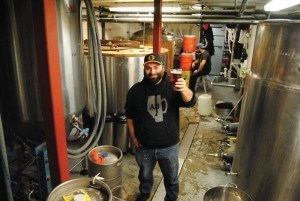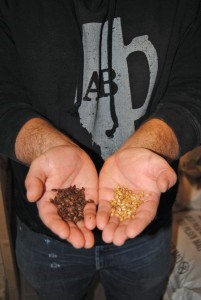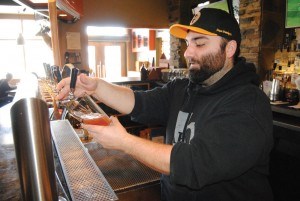
Beer is one of the oldest prepared drinks in the world, yet even today, nearly 5,000 years after it was first created, it’s constantly being reinvented.
No one in Jasper knows that better than John Palko, head brewer for the Jasper Brewing Company, who spends countless hours toiling over new recipes to create the next great beer.
“There’s more to beer than just drinking it,” said Palko, who holds a masters of chemistry from Carleton University in Ottawa.
“One of the things that I’ve learned is drinking fresh beer matters.”
Just like making a meal from scratch, brewing takes patience, time and imagination.
For Palko that’s the best part of his job.
“With my science background I like experimenting with recipes,” he said. “I like trying to figure out how I can use different ingredients to produce the same style of beer.”

Before creating a brand new batch, Palko spends a lot of time testing various combinations of malted barley and hops—two of the primary ingredients found in beer—as well as tinkering with different temperatures throughout the entire process.
Once he has pinpointed the right combination of ingredients, it’s time to scale up the recipe for commercial production.
The first order of business starts in the grain room, where he can choose from 15 to 20 different types of malted barley, depending on the type of beer he is trying to create.
The barley ranges from pale malts to roasted malts and each one carries its own unique flavour.
According to Palko, most brewers use one or two malts to make simpler beers, such as honey ale, and up to five varieties of malt to create stronger more complex beers such as an India pale ale.
From here the various combinations of the malted barley are thrown into a small mill before being sent off to the “mash tun,” a large vessel that uses hot water to convert the starches in the crushed grain into sugars for fermentation. This process is known as “mashing.”
In Jasper, the mash tun can hold up to 600 litres, depending on the amount of grain being used in the recipe.
Once the mashing is complete, the liquid extracted from the process is called “wort.” Wort is a sugary liquid that will eventually be fermented to produce alcohol.
From here the liquid is transferred to the “boil kettle” where hops is added. Hops is a flower that is dried and used to add bitterness, aroma and flavour.
Once the hops is added, the wort is boiled for 90 minutes and stirred with a metal oar to create a whirlpool effect.
This helps to separate the solids from the liquids, leaving behind “trub” in the bottom of the kettle.
Due to Jasper’s altitude, the boiling point is between 96 and 97 degrees Celsius, explained Palko.
From here the hot wort is transferred through a heat exchanger into one of eight fermentation vessels.
The heat exchanger cools the wort to a specific temperature depending on the beer, but usually falls somewhere between 12 and 22 degrees Celsius.
According to Palko, it takes 1,200 litres of water to cool about 900 litres of hot wort. To avoid wasting water and running up massive water bills, that water is stored and reused at a later date.
After the wort is cooled, and inside a fermentation vessel, yeast is added along with dissolved oxygen.
For the next day and a half the yeast grows to about three to five times its size as it reacts with the wort, creating alcohol and carbon dioxide through a natural process known as fermentation.
Throughout the process the wort is continuously being cooled at a consistent temperature. The colder the temperatures, the more the yeast settles, making for a clearer beer.
For Palko, this is very important because the Jasper Brewing Company doesn’t filter its beer, like many other breweries.
After the beer has finished fermenting, it is transferred to a nearby fridge for storage in conditioning tanks.

At this point, carbon dioxide is added to the beer and it is ready to be consumed.
“Essentially you can read all of this in a book, but to actually be able to taste the effects while performing it yourself is probably one of my favourite parts of the job,” said Palko.
According to Palko, in the summer months, at the height of the tourist season, people are usually drinking beer that is seven or eight days old, from the time it was brewed. In the shoulder season, that stretches to about 30 days.
In fact, the Jasper Brewing Company will go through all 10 conditioning tanks, which hold approximately 1,800 litres, in 12 days during the summer season, said Palko.
In a nod to the community, all but one of the company’s beers that are currently on tap are named after something that is unique to Jasper, from Jasper the Bear to Steam Engine 6060, which was brought back to life by Jasperite Harry Home.
“Our motto is ‘creating a community-focused beer culture,’” said Palko.
In addition to creating unique craft beers, the brewery also brews seasonal ales and beers for local events.
Its most recent creation was the Dark Sky Dark Rye beer, made specifically for the Dark Sky Festival in October. In September, the company created a beer specifically for the Jasper Folk Music Festival.
In addition to creating beer for special events, the company also makes beer to recognize different organizations in town.
In the coming weeks the brewery intends to make a seasonal beer called Old Man Winter Ale and a community beer called HIV West Yellowhead Red IPA.
Paul Clarke
[email protected]
